This introduction gives you an overview of what diabetes is, and what life with a diabetic dog is like. Many of the things talked about here are explored in more detail later – this is just to give you an overview.
Quick Links
What is Diabetes?
Dogs with diabetes have lost the ability to produce the hormone insulin in their pancreas. Insulin is responsible for controlling the of glucose (sugar) in the blood, and so dogs with untreated diabetes have very high levels of sugar in their blood.
Diabetes in dogs is similar to type 1 diabetes in humans, as all patients are treated with insulin. However, type 1 diabetes in humans is normally diagnosed in children and young adults, whereas most dogs are middle-aged or older when they are diagnosed.
What Causes Diabetes in Dogs?
There is no one single thing that causes a dog to develop diabetes. Genetics plays a strong role—we know that certain breeds are more prone to develop it, and if a dog has a parent or sibling with the condition, they are more likely to develop it themselves. There may also be a link with excess weight, but most overweight dogs will not develop diabetes. If a dog is on the edge of developing diabetes, some medications may tip them over the edge to start showing symptoms.
Symptoms of Diabetes
The symptoms of diabetes will vary, and most dogs do not experiences all of these symptoms. Common symptoms include:
· Drinking more
· Urinating more
· Increased hunger
· Weight loss
· Vomiting occasionally
· Diarrhoea
· Low energy
Ketoacidosis
The symptoms of diabetes will vary, and most dogs do not experiences all of these symptoms. Common symptoms include:
If diabetes has been present for a while, or if a dog develops an infection that makes them sicker, they can develop a more serious condition called Diabetic Ketoacidosis (DKA). Dogs with DKA will have slightly different symptoms to when they initially developed diabetes, which include:
· Drinking more
· Urinating more
· Not eating
· Vomiting profusely
· Diarrhoea
· Collapse
Not every sick diabetic dog has DKA, but it is a life-threatening condition. We recommend that you bring your dog in for a check-up if they have any unexpected illness.
Treatment
The treatment for diabetes is insulin injections to replace the hormones that the dog’s body is no longer able to make itself. This is usually done twice a day, either using a needle and syringe or an insulin “pen”. You will need to learn to give these injections at home—this can sound daunting, but will quickly become routine once you are used to how the equipment works.
The key to successful treatment of diabetes is a constant routine. Ideally, your dog will be given the same insulin injections at the same time every day, and be fed the same food at the same time also. The closer you can stick to a regular schedule, the more successful the treatment is likely to be.
In most cases, diabetes can be treated very successfully in dogs. You dog should get back to a good quality of life, and the life expectancy of diabetic dogs is no different than that of a normal dog of their age. Unlike cats or humans, it is not possible for dogs to go into remission (that is, to be cured of their diabetes, either temporarily or permanently) and so treatment will need to continue for the rest of their lives.
There are a few cases where the diabetes may not be easy to treat, either because there is another underlying condition that is complicating things, or because of the way a particular dog’s body works.
If you’re concerned your dog may have diabetes, or if they’ve already been diagnosed and you need guidance, we’re here to help. Contact your nearest practice today to speak with our caring veterinary team and ensure your dog gets the support they need.
Find a Vet Practice Near You
Our Latest News and Advice

Join our Pet Healthcare Plan, the Kin Care Club.
Our comprehensive pet healthcare plan is designed to help you give your cat or dog the best care, while keeping your budget in mind.
Whether you’re looking for essential coverage or complete peace of mind, the Kin Care Club offers two flexible plans tailored to your needs and your pet’s wellbeing.
